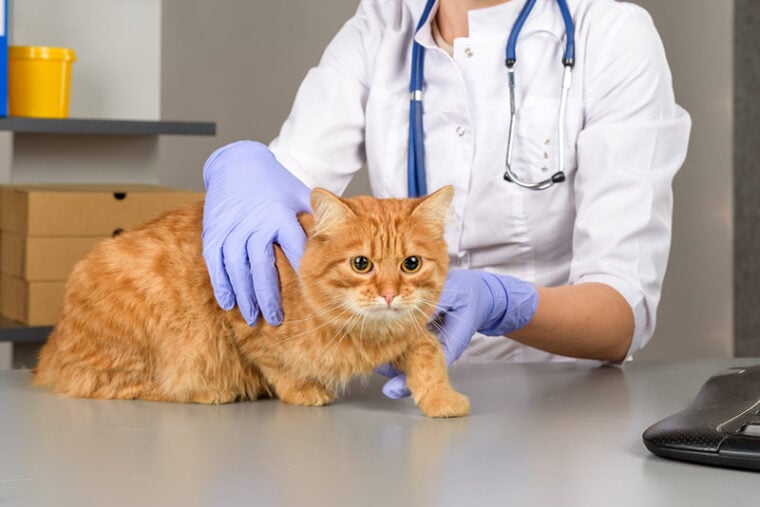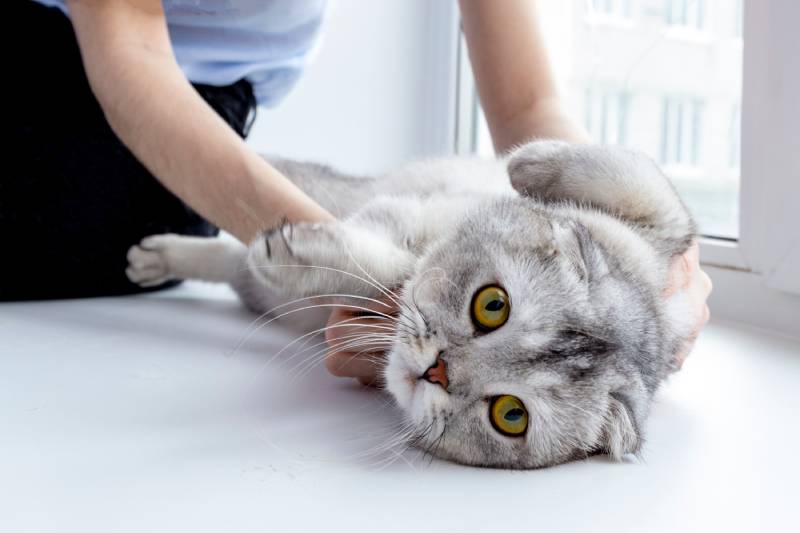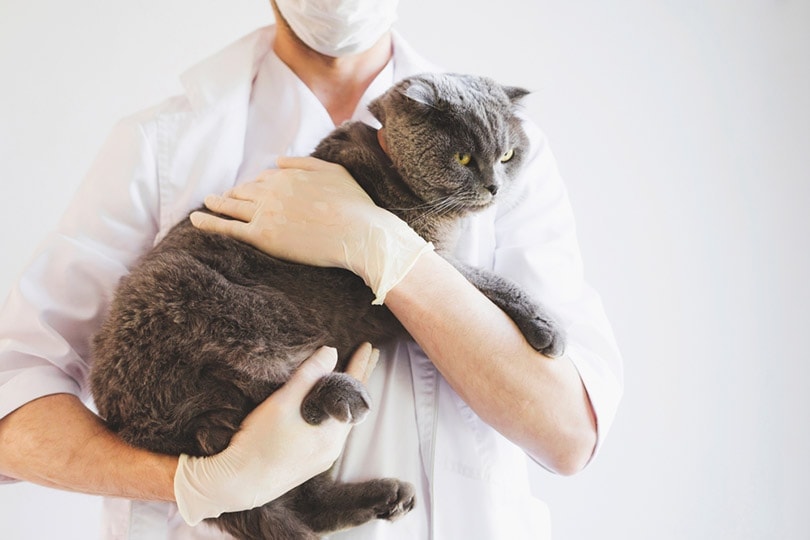
Click to Skip Ahead
Last week, your cat was their normal, happy self—investigative, playful, and delighted to cause mischief. Today, they seem withdrawn and reluctant to move around the house. What could have caused this sudden change in your normally feisty feline?
Septic arthritis, while uncommon, is a potential cause of sudden lameness in cats. The following article will discuss the details of this condition to help you navigate what a diagnosis of septic arthritis may mean for your normally playful pet.
What is Septic Arthritis?
Septic arthritis is an uncommon, inflammatory joint disease caused by infection with a microorganism, such as a bacterium, virus, or fungus. In felines, these infectious agents typically cause signs through direct infection of the synovium, an important type of specialized tissue located within the joint capsule.
Septic arthritis can affect either a single joint (monoarthritis) or multiple joints (polyarthritis), and may present with a wide range of clinical signs, depending on the specific infectious agent and duration of infection.

What Are the Causes of Septic Arthritis?
Septic arthritis in cats may be caused by a wide variety of organisms, including the following:
While the above-noted organisms have all been implicated in cases of feline septic arthritis, this condition is most often caused by bacterial infection. The most common cause of septic arthritis in felines is a cat bite wound penetrating a joint. Specific joints at the highest risk of infection during a catfight include the carpus, hock, and interphalangeal joints.
Septic arthritis typically affects a single joint in felines; however, multiple joints may be affected when there is an infection caused by bacterial spread through the bloodstream. This may occur in cases of umbilical infection in neonatal kittens, or cases of infection with Mycoplasma bacterial species. Cats affected by Mycoplasma polyarthritis often have a suppressed immune system and may have underlying diseases, such as Feline Immunodeficiency Virus (FIV), Feline Leukemia Virus (FeLV), or lymphoma.

What Are the Signs of Septic Arthritis?
Signs of septic arthritis in felines may vary, especially if an underlying medical condition is present. Most cases of acute arthritis, however, will include a combination of the following clinical signs:
If any of the above-noted signs are observed at home, a prompt visit to the veterinarian is needed for further evaluation.
How is Septic Arthritis Diagnosed?
A detailed history and thorough physical exam will help your veterinarian further evaluate potential causes of your cat’s signs. They may ask questions regarding your feline’s lifestyle (such as whether they have outdoor access), as well as inquire whether any recent fights or wounds have been observed at home. Your veterinarian’s exam will likely include careful palpation of your cat’s legs and observation of them walking in the exam room.
In addition to an examination and history, your veterinarian may also recommend diagnostic testing for further evaluation. A complete blood count, blood chemistry, and urinalysis may be considered and can show evidence of inflammation within the body. Radiographs (x-rays) may also be recommended and can demonstrate evidence of fluid or boney change within affected joints.
If your veterinarian has a strong suspicion of septic arthritis, they may recommend a diagnostic procedure called an arthrocentesis. Your cat will likely need to undergo general anesthesia for this procedure, which involves the sterile collection of fluid from an affected joint. Fluid analysis and cultures of joint fluid may reveal inflammatory cells and bacterial growth, respectively. Additional tests, such as cultures of blood and urine, as well as testing for infectious diseases (such as FIV and FeLV) may also be recommended.

What Are the Potential Dangers of Septic Arthritis?
Depending on the specific infectious agent causing septic arthritis, damage to cartilage and bone may result and contribute to decreased joint function and lameness that persist after treatment. As with any illness, early recognition, diagnosis, and treatment may help to provide the best outcome for affected felines.
In addition to lameness, cats with septic arthritis are frequently systemically ill; meaning that they display signs of illness affecting the entire body. Signs of septic arthritis, such as decreased appetite or anorexia, may predispose felines towards developing hepatic lipidosis, a life-threatening condition affecting the liver. Cats with signs of systemic illness secondary to septic arthritis may require hospitalization and supportive care to ensure their pain is adequately controlled and that their nutritional needs are being met.
Frequently Asked Questions (FAQs)
How is Septic Arthritis Treated?
Treatment for septic arthritis will be directed at the microorganism causing infection. As most feline septic arthritis cases are caused by bacterial infection, antibiotic medication is likely to be an important component of treatment; extended courses lasting at least 4–6 weeks are often needed.
Symptomatic and supportive care, such as pain medication, hospitalization for intravenous fluids, or feeding assistance may be needed on a case-by-case basis. Cage rest is often recommended to allow affected cartilage time to heal.
Surgical treatment involving flushing of an infected joint cavity, and removal of dead or diseased tissue, may be needed in severe cases of septic arthritis.

Is Septic Arthritis the Same as Osteoarthritis?
No. Osteoarthritis—also known as degenerative joint disease, or DJD—is a common, degenerative, non-inflammatory joint disease that has been noted in 60–90% of geriatric felines. Signs of osteoarthritis in felines tend to be mild. Septic arthritis, in contrast, is an inflammatory joint disease seen relatively rarely in cats. Typically, affected cats are markedly lame, and systemic signs of disease are noted commonly.
Conclusion
In summary, while rare, septic arthritis is a disease that can significantly impact our feline friends. If signs of this concerning condition are noted, timely evaluation by a veterinarian is needed in order to get your cat on the road to recovery as soon as possible!
Featured Image Credit: M. Arkhipov, Shutterstock







